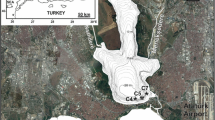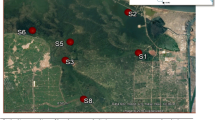Abstract
Two hundred and forty-six surface and buried sediment samples from Newark Bay, New Jersey, and its major tributaries (Passaic River, Hackensack River, Newark Bay, Arthur Kill, Elizabeth River, and Kill Van Kull) were assayed for p,p′-dichlorodiphenyltrichloroethane (p,p′-DDT), p,p′-dichlorodiphenyldichloroethane (p,p′-DDD), and p,p′-dichlorodiphenylchloroethylene (p,p′-DDE) between February 1990 and March 1993. Chronological profiles in sediments from pre-1940 to the present were determined by radioisotope activities of 210Pb and 137Cs. The concentrations of these chemicals were compared to National Oceanic and Atmospheric Administration (NOAA) benchmark sediment values (Long and Morgan 1991). The objectives were to (a) determine the spatial and temporal distributions of DDT compounds in sediments, (b) identify possible sources, and (c) assess the potential for sediment toxicity within the estuary. Mean concentrations in surface sediments in individual waterways ranged from 5 to 473 μg/kg for p,p′-DDT, 18 to 429 μg/kg for p,p′-DDD, and 5 to 111 μg/kg for p,p′-DDE. A regional background mean concentration of approximately 100–300 μg/kg Σp,p′-DDT (sum of p,p′-DDT, p,p′-DDD, and p,p′-DDE) was measured in surface sediments throughout the estuary, with the exception of the Arthur Kill, where mean concentrations exceeded 700 μg/kg. The elevated concentrations found in recently deposited surface sediments in the Arthur Kill may be due to the presence of ongoing sources. The highest concentrations in buried sediments occurred in the lower Passaic River at depths corresponding to historical deposits from 1940 to 1970, the peak time period for production and usage of DDT in the United States. Comparisons to NOAA benchmark sediment toxicity values indicate that p,p′-DDT, p,p′-DDD, and p,p′-DDE concentrations in surface sediments may pose a potential hazard to fish, shellfish, and other benthic and demersal organisms in some portions of the estuary, particularly in the upper and lower Arthur Kill.
Similar content being viewed by others
References
Agarwal HC, Mittal PK, Menon KB, Pillai MKK (1986) DDT residues in the River Jamuna in Delhi, India. Water Air Soil Pollut 28:89
Aguillar A (1984) Relationship of DDE/DDT in marine mammals to the chronology of DDT input to the ecosystem. Can J Fish Aquat Sci 41:840–844
Belton TJ, Hazen R, Ruppel BE, Lockwood KR, Mueller JA, Stevenson E, Post JJ (1985) A study of dioxin (2,3,7,8-tetrachlorodibenzo-p-dioxin) contamination in select finfish, crustaceans, and sediments of New Jersey waterways. New Jersey Department of Environmental Protection, Office of Science and Research, Trenton, NJ
Bonnevie NL, Gunster DG, Wenning RJ (1992) Lead contamination in surficial sediments from Newark Bay, New Jersey. Environ Int 18:497–508
Bopp RF, Simpson HJ (1985) Contamination of the Hudson River: The sediment record. Lamont-Doherty Geological Observatory, Columbia University,NY
--, -- (1991) Sediment sampling and radionuclide and chlorinated hydrocarbon analysis in Newark Bay and the Hackensack and Passaic Rivers. Contract No. P24096. Submitted to the New Jersey Department of Environmental Protection, Division of Science and Research, Trenton, NJ
Bopp RF, Gross ML, Tong H, Simpson HJ, Monson SJ, Deck BL, Moser FC (1991) A major incident of dioxin contamination: Sediments of New Jersey estuaries. Environ Sci Technol 25(5):951–956
Brooks GT (1979) Chlorinated insecticides, vol 1. CRC Press, Boca Raton, FL
Brown DA, Gossett RW, Hershelman GP, Ward CF, Westcott AM, Cross JN (1986) Municipal wastewater contamination in the Southern California Bight: Part I—Metal and organic contaminants in sediments and organisms. Mar Environ Res 18:291–310
Budavari S, O'Neil MJ, Smith A, Heckelman PE (1989) The Merck index: An encyclopedia of chemicals, drugs, and biologicals, 11th ed. Merck & Co, Inc, Rahway, NJ
Buhler DR, Rasmusson ME, Shanks WE (1969) Chronic oral DDT toxicity in juvenile coho and chinook salmon. Toxicol Appl Pharmacol 14:535–555
Ellgaard EG, Ochsner JC, Cox JK (1977) Locomotor hyperactivity induced in the bluegill sunfish, Lepomis macrochirus, by sublethal concentrations of DDT. Can J Zool 55:1077–1081
Fingerman SW, van Meter C, Fingerman M (1979) Increased spontaneous locomotor activity in the fiddler crab, Uca pugilator, after exposure to a sublethal concentration of DDT. Bull Environ Contam Toxicol 21:11–16
Fry DM, Toone CK (1981) DDT-induced feminization of gull embryos. Science 213:922–924
Gillis CA, Bonnevie NL, Wenning RJ (1993) Mercury contamination in the Newark Bay Estuary. Ecotoxicol Environ Saf 25: 214–226
Gosselin RE, Smith RP, Hodge HC (1984) Clinical toxicology of commercial products, Williams & Wilkins, Baltimore, MD
Gunster DG, Bonnevie NL, Gillis CA, Wenning RJ (1993) Assessment of chemical loadings to Newark Bay, New Jersey from petroleum and hazardous chemical accidents occurring from 1986 to 1991. Ecotoxicol Environ Saf 25:202–213
Haas CN, Scheff PA (1990) Estimation of averages in truncated samples. Environ Sci Technol 24(6):912–919
Hauge P, Morton P, Boriek M, Casey G (1990) Polychlorinated biphenyls (PCBs), chlordane, and DDTs in selected fish and shellfish from New Jersey waters, 1986–1987: Results from New Jersey's Toxics in Biota Monitoring Program. New Jersey Department of Environmental Protection, Division of Science and Research, Trenton, NJ
Hauge P (1993) Polychlorinated biphenyls (PCBs), chlordane, and DDTs in selected fish and shellfish from New Jersey Waters, 1988–1991: Results from New Jersey's Toxics in Biota Monitoring Program. New Jersey Department of Environmental Protection, Division of Science and Research, Trenton, NJ
Huntley SL, Bonnevie NL, Wenning RJ (1994) Polycyclic aromatic hydrocarbon and petroleum hyrdocarbon contamination in sediment from the Newark Bay Estuary, New Jersey. Arch Environ Contam Toxicol 28(1):93–107
HydroQual (1991) Assessment of pollutant loadings to New York-New Jersey Harbor. U.S. Environmental Protection Agency, Office of Water Quality and Standards, Washington, DC
International Technology Corporation (1986) Passaic River sediment study, final report. Pittsburgh, PA. Prepared for the New Jersey Department of Environmental Protection, Trenton, NJ, March
Johnson RE (1976) DDT metabolism in microbial systems. Residue Rev 61: 1–28
Johnson A, Norton D, Yake B (1988) Persistence of DDT in the Yakima River drainage, Washington. Arch Environ Contam Toxicol 17:289–297
Killam Associates Inc (1976) Report Upon Overflow Analysis to Passaic Valley Sewerage Commissioners on Passaic River Overflows, Trenton, NJ
Koivusaari J, Nuuja I, Palokangas R, Finnlund M (1980) Relationships between productivity, eggshell thickness and pollutant contents of addled eggs in the population of white-tailed eagles Haliaetus-Albicilla L in Finland during 1969–1978. Environ Pollut Ser A—Ecol Biol 23(1):41–52
Lingaraja T, Rao PSB, Venugopalan VK (1979) DDT induced ethological changes in estuarine fish. Environ Biol Fish 4(1):83–88
Long ER, Morgan LG (1991) The potential for biological effects of sediment-sorbed contaminants tested in the national status and trends program. NOS OMA 52, 2nd printing. National Ocean Service, Seattle, WA
Long ER, Wolfe DA, Stern EA, Thursby GB (1993) Sediment toxicity in the Hudson-Raritan Estuary. In: Society of Environmental Toxicology and Chemistry (SETAC, Pensacola, FL) abstract book, 14th annual meeting: Ecological risk assessment: Lessons learned? Abstract #341. Nov. 14–18, 1993, Houston, TX
Macek, KJ (1968) Reproduction in brook trout (Salvelinus fontinalis) fed sublethal concentrations of DDT. J Fish Res Board Can 25(9):1787–1796
Menzer RE, Nelson JO (1986) Water and soil pollutants. In: Klassan CD, Amdur MO, Doull J (eds) Cassarett and Doull's Toxicology: The basic science of poisons, 3rd ed. Macmillan Publishing, NY
Newton I, Bogan JA, Haas MB (1989) Organochlorines and mercury in the eggs of British peregrines Falco peregrinus. Ibis 131:355–376
National Oceanic and Atmospheric Administration (NOAA) (1982) Contaminant inputs to the Hudson-Raritan Estuary. OMPA-21 National Ocean Service, Rockville, MD
— (1990) Damage assessment plan: Los Angeles/Long Beach Harbors, Palos Verdes Shelf, and ocean dump sites. National Ocean Service, Rockville, MD
Odermatt JR, Johnson TA, Hummeldorf RG (1993) Distribution of DDT residues (DDT, DDD, and DDE) in California soils. J Soil Contam 2(4):315–329
Olsen CR, Larsen IL, Brewster RH, Cutshall NH, Bopp RF, Simpson HJ (1984) A geochemical assessment of sedimentation and contaminant distributions in the Hudson-Raritan Estuary. NOS OMS 2. National Oceanic and Atmospheric Administration, Rockville, MD
Pavoni R, Sfriso A, Marcomini A (1987) Concentration and flux profiles of PCBs, DDTs, and PAHs in a dated sediment core from the lagoon of Venice. Mar Chem 21:25–35
Pham T, Lum K, Lemieux C (1993) The occurrence, distribution, and sources of DDT in the St. Lawrence River, Quebec (Canada). Chemosphere 26(9):1595–1606
Phillips JH, Haderlie EE, Lee WL (1974) An analysis of the dynamics of DDT and its derivatives, DDD and DDE, in marine sediments. US Environmental Protection Agency, Office of Research and Development, Corvallis, OR
Randers J (1972) System simulation to test environmental policy: DDT. Int J Environ Stud 4:51–61
Reich AR, Perkins JL, Cutter G (1986) DDT contamination of a north Alabama aquatic ecosystem Environ Toxicol Chem 5:725–736
Rod SR, Ayres RU, Small M (1989) Reconstruction of historical loadings of heavy metals and chlorinated hydrocarbon pesticides in the Hudson-Raritan Basin, 1880–1980. Carnegie Mellon University, Department of Engineering and Public Policy, Pittsburgh, PA
Sericano JL, Wade TL, Atlas EL, Brooks JM (1990) Historical perspective on the environmental bioavailability of DDT and its derivatives to Gulf of Mexico oysters. Environ Sci Technol 24:1541–1548
Spitzer PR, Risebrough RW, Walker W, Hernandez R, Poole A, Puleston D, Nisbet ICT (1978) Productivity of ospreys in Connecticut-Long Island increases as DDE residues decline. Science 202 (Oct 20):333–335
Suflita JM, Gerba CP, Ham RK, Palmisano AC, Rathje WL, Robinson JA (1992) The world's largest landfill: A multidisciplinary investigation. Environ Sci Technol 26(8):1486–1495
Suns KR, Hitchin GG (1992) Species-specific differences in organochlorine accumulation in young-of-the-year spottail shiners, emerald shiners, and yellow perch. J Great Lakes Res 18(2):280–285
Suszkowski DJ (1978) Sedimentology of Newark Bay, New Jersey: An urban estuarine bay. Ph.D. Dissertation, University of Delaware, Newark, DE
Suszkowski DJ, Cairns S, Heimbach D (1990) Data management and analysis (Task 8.1) report, New York/New Jersey Harbor Estuary Program (FY 89). Science and Environmental Science Inc, NY
U.S. Environmental Protection Agency (1972) Public Notices 71–1, 71–2, and 71–5, June 14. USEPA, Washington, DC
— (1974) An analysis of the dynamics of DDT and its derivatives, DDD and DDE, in marine sediments. Pacific Northwest Environmental Research Laboratory, Corvallis, OR
— (1975) DDT: a review of scientific and economic aspects of the decision to ban its use as a pesticide. Criteria and Evaluation Division, Washington, DC
— (1982) Arthur Kill water quality survey. Office of Water Criteria and Standards, Washington, DC
— (1987) Record of decision: Chemical Control Corporation Superfund Site, Elizabeth, NJ. Region II, NY
Webber EC, Bayne DR, Seesock WC (1989) DDT contamination of benthic invertebrates and sediments from tributaries of Wheeler Reservoir, Alabama. Arch Environ Contam Toxicol 18:728–733
Whipple W, Hunter JV, Yu SL (1976) Characterization of urban run-off—New Jersey. Water Resources Research Institute, Rutgers University, Trenton, NJ
Wilber WG, Hunter JV (1979) Distribution of metals in street sweepings, stormwater solids, and urban aquatic sediments. J Water Pollut Con Feder 51(12):2811–2822
Willes RF, Nestmann ER, Miller PA, Orr JC, Munro IC (1993) Scientific principles for evaluating the potential for adverse effects from chlorinated organic chemicals in the environment. Reg Toxicol Pharmacol 18:313–356
Yamashita N, Tanabe S, Ludwig JP, Kurita H, Ludwig ME, Tatsukawa R (1993) Embryonic abnormalities and organochlorine contamination in double-crested cormorants (Phalacrocorax auritus) and caspian terns (Hydroprogne caspia) from the upper Great Lakes in 1988. Environ Pollut 79:163–173
Author information
Authors and Affiliations
Rights and permissions
About this article
Cite this article
Gillis, C.A., Bonnevie, N.L., Su, S.H. et al. DDT, DDD, and DDE contamination of sediment in the Newark Bay estuary, New Jersey. Arch. Environ. Contam. Toxicol. 28, 85–92 (1995). https://doi.org/10.1007/BF00213973
Received:
Revised:
Issue Date:
DOI: https://doi.org/10.1007/BF00213973




